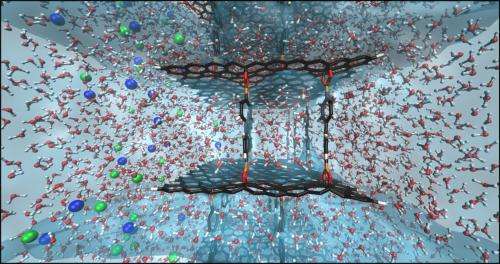Simulations point to graphene oxide frameworks potential in water purification

(Phys.org) —Computational modeling has given materials researchers new insight into the properties of a membrane that purifies saltwater into potable water. The resulting technology could help speed up inefficient desalination processes in use today.
Researchers at Oak Ridge National Laboratory and Rensselaer Polytechnic Institute used supercomputer simulations at RPI's Center for Computational Innovations to explore the purification potential of a hybrid material called graphene oxide frameworks, or GOFs, first introduced in 2010.
"This is basically sheets of oxidized graphene connected by specific chemical linkers from some of the oxidation sites," said ORNL's Bobby Sumpter. "Because it's composed mainly of strongly bonded carbon, it doesn't decompose in water and has good mechanical properties. It's an exciting material with potential for numerous applications."
Initially intrigued by GOFs' tunable electronic properties, Sumpter and RPI's Vincent Meunier soon realized the material could be used as a desalination membrane.
Reverse osmosis systems, which make up approximately 40 percent of the world's desalination capacity, generate fresh water by applying pressure to force saltwater through a semi-permeable membrane.
"One big problem for desalination is speed—how much water can you push through per day," said Meunier, the Gail and Jeffrey L. Kodosky '70 Constellation Professor of Physics, Information Technology, and Entrepreneurship at RPI. "You can have a great membrane material but if you can treat only a cup of water a day, that's not going to be useful or cost-effective."
After developing computational models to describe the interactions among the material's atoms, Sumpter, Meunier and RPI's Adrien Nicolaï set out to compute the ideal configuration for a GOF desalination membrane. They used high-performance computers to simulate how layer thickness, the density of the linking pillars, and applied pressure affect the material's performance.
"There's a sweet spot for the density of the linkers," Meunier said. "If you have a high density of linkers, it'll be super selective, but it will also slow it down. You need both selectivity and permeability."
The simulations revealed that fine-tuning the GOF structure results in the ability to remove all the ions from saltwater at a much quicker rate—approximately 100 times faster than the materials currently used as reverse osmosis membranes. The use of water-repellent graphene as part of the porous membrane contributes to the increased performance.
"Water is trying to avoid being in contact with graphene, so you can design it in such a way that you're forcing the water not to be close to one layer but also not to be close to the other," Meunier said. "This effect creates channels, which direct water through the system very quickly."
The team's most recent simulations focused on the removal of salt ions, but the researchers note that the GOF material could be used as filtration membranes for other contaminants such as bacteria. Since GOFs are made with abundant, inexpensive materials through a standard fabrication process, the researchers also believe that the GOF-based membranes could help make desalination more economically viable.
"We believe it's scalable, that the chemical engineering industry could potentially produce it in bulk," Sumpter said.
The team's latest results are published as "Tunable water desalination across graphene oxide framework membranes" in the journal Physical Chemistry Chemical Physics. The Office of Naval Research and the Department of Energy's Office of Science supported the research.
Sumpter adds that the team's project exemplifies how interdisciplinary collaborations—combining materials science, physical chemistry, biophysics and computational simulation—can produce significant results.
"Understanding in different disciplines is critical for enabling these important examples of science," he said. "That's the benefit of nanoscience, where multiple fields come together to solve a problem that's important to society."
More information: "Tunable water desalination across graphene oxide framework membranes." Adrien Nicolaï, Bobby G. Sumpter and Vincent Meunier. Phys. Chem. Chem. Phys., 2014,16, 8646-8654. DOI: 10.1039/C4CP01051E
Journal information: Physical Chemistry Chemical Physics
Provided by Oak Ridge National Laboratory



















